ITECH1100 Report: Potential Impact of Smartphones on Public Transport
VerifiedAdded on 2023/04/21
|9
|1782
|399
Report
AI Summary
This report examines the potential impact of smartphones on the public transport industry. It begins with research on the increasing influence of smartphones across various sectors, highlighting how consumers utilize mobile devices for business and personal purposes. The report delves into the advantages of smartphones in public transport, such as improved communication, real-time vehicle tracking, and mobile payment gateways. It explores parallels with other industries, like retail and finance, where smartphones have driven growth. The report also discusses the integration of other technologies in the transport sector, including transport drones and vehicle-to-vehicle communication. Furthermore, it analyzes the regulatory and ethical considerations related to smartphone use in transport and examines how smartphones can disrupt existing processes, particularly in fare management. The report concludes with a diagram illustrating the impact of smartphones on fare management, emphasizing the transformative potential of mobile technology in public transport.
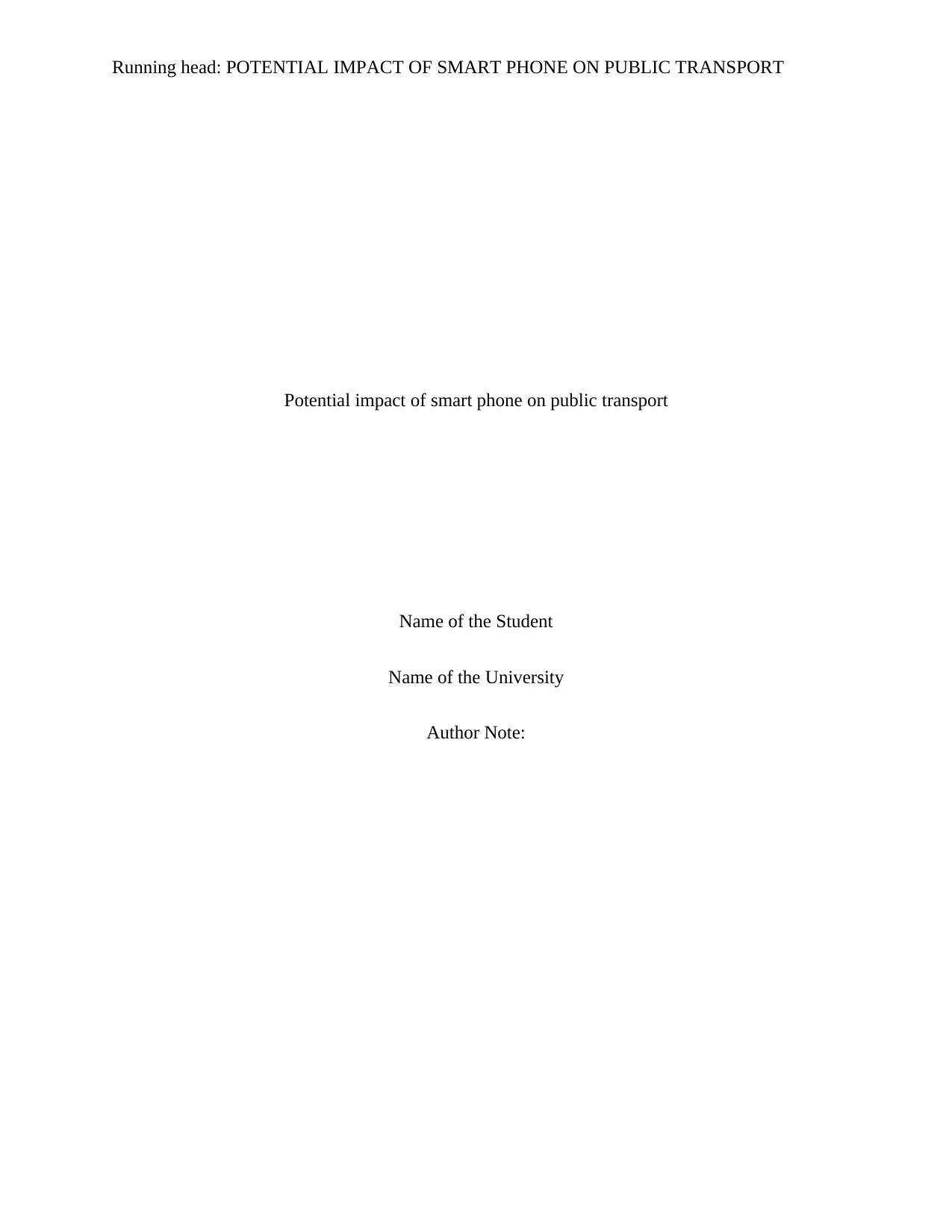
Running head: POTENTIAL IMPACT OF SMART PHONE ON PUBLIC TRANSPORT
Potential impact of smart phone on public transport
Name of the Student
Name of the University
Author Note:
Potential impact of smart phone on public transport
Name of the Student
Name of the University
Author Note:
Paraphrase This Document
Need a fresh take? Get an instant paraphrase of this document with our AI Paraphraser
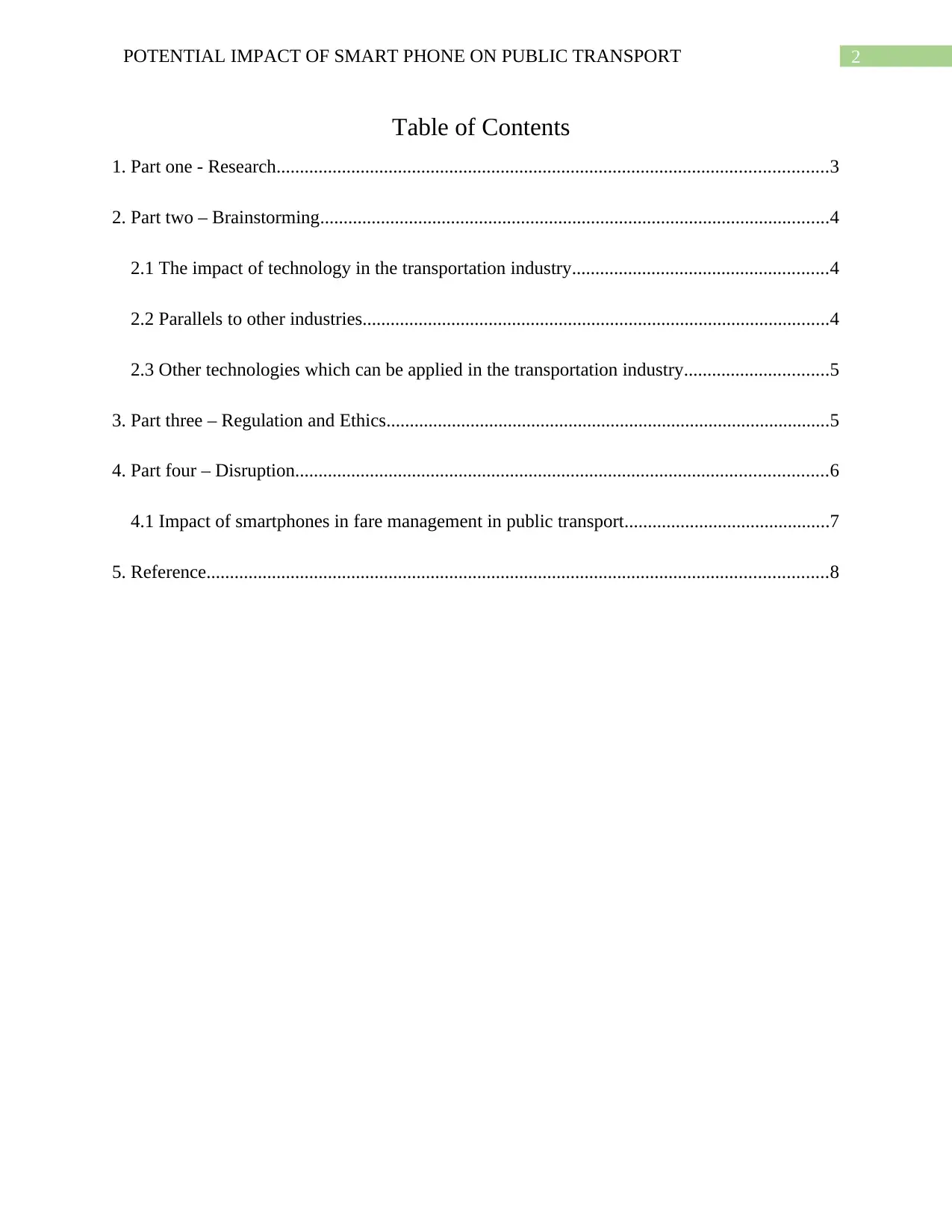
2POTENTIAL IMPACT OF SMART PHONE ON PUBLIC TRANSPORT
Table of Contents
1. Part one - Research......................................................................................................................3
2. Part two – Brainstorming.............................................................................................................4
2.1 The impact of technology in the transportation industry.......................................................4
2.2 Parallels to other industries....................................................................................................4
2.3 Other technologies which can be applied in the transportation industry...............................5
3. Part three – Regulation and Ethics...............................................................................................5
4. Part four – Disruption..................................................................................................................6
4.1 Impact of smartphones in fare management in public transport............................................7
5. Reference.....................................................................................................................................8
Table of Contents
1. Part one - Research......................................................................................................................3
2. Part two – Brainstorming.............................................................................................................4
2.1 The impact of technology in the transportation industry.......................................................4
2.2 Parallels to other industries....................................................................................................4
2.3 Other technologies which can be applied in the transportation industry...............................5
3. Part three – Regulation and Ethics...............................................................................................5
4. Part four – Disruption..................................................................................................................6
4.1 Impact of smartphones in fare management in public transport............................................7
5. Reference.....................................................................................................................................8
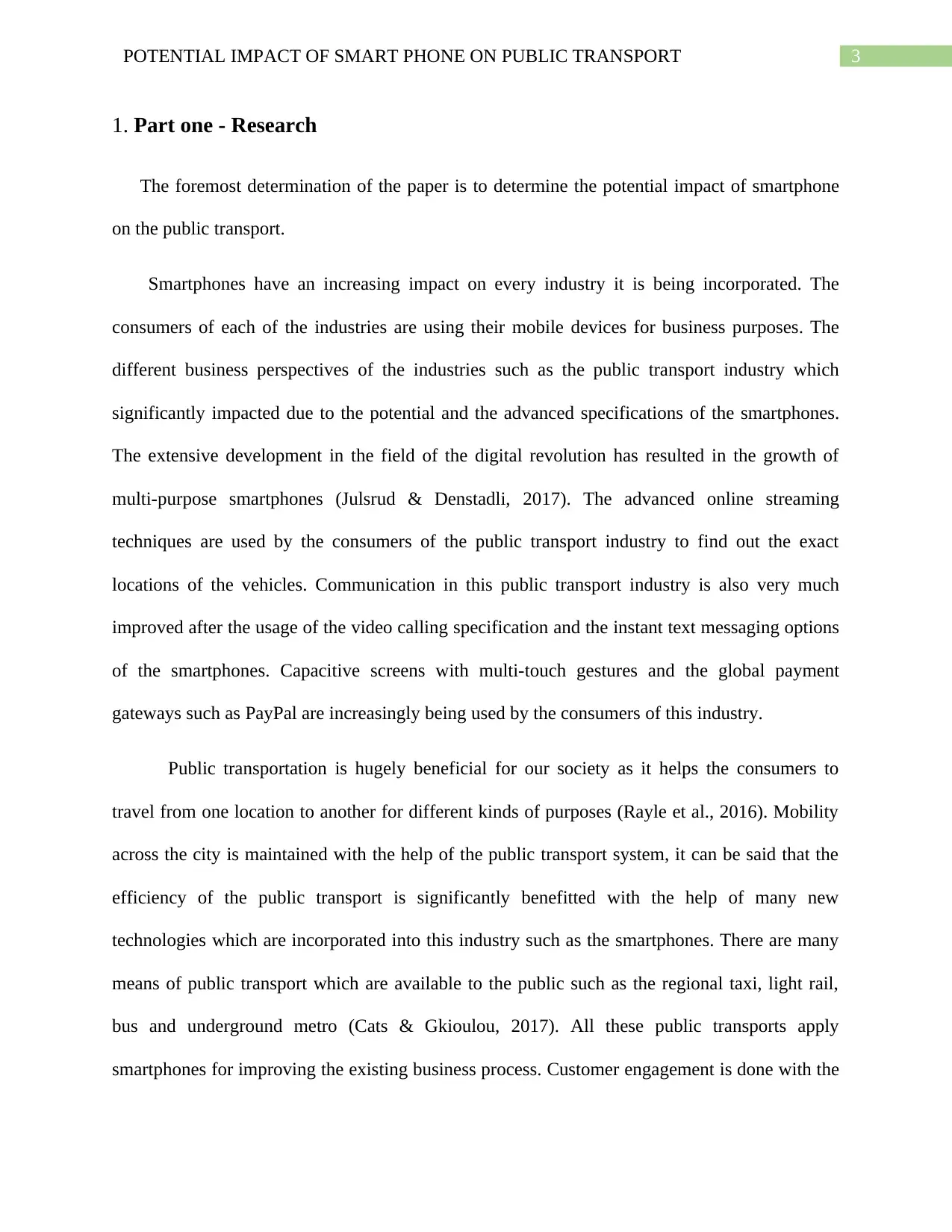
3POTENTIAL IMPACT OF SMART PHONE ON PUBLIC TRANSPORT
1. Part one - Research
The foremost determination of the paper is to determine the potential impact of smartphone
on the public transport.
Smartphones have an increasing impact on every industry it is being incorporated. The
consumers of each of the industries are using their mobile devices for business purposes. The
different business perspectives of the industries such as the public transport industry which
significantly impacted due to the potential and the advanced specifications of the smartphones.
The extensive development in the field of the digital revolution has resulted in the growth of
multi-purpose smartphones (Julsrud & Denstadli, 2017). The advanced online streaming
techniques are used by the consumers of the public transport industry to find out the exact
locations of the vehicles. Communication in this public transport industry is also very much
improved after the usage of the video calling specification and the instant text messaging options
of the smartphones. Capacitive screens with multi-touch gestures and the global payment
gateways such as PayPal are increasingly being used by the consumers of this industry.
Public transportation is hugely beneficial for our society as it helps the consumers to
travel from one location to another for different kinds of purposes (Rayle et al., 2016). Mobility
across the city is maintained with the help of the public transport system, it can be said that the
efficiency of the public transport is significantly benefitted with the help of many new
technologies which are incorporated into this industry such as the smartphones. There are many
means of public transport which are available to the public such as the regional taxi, light rail,
bus and underground metro (Cats & Gkioulou, 2017). All these public transports apply
smartphones for improving the existing business process. Customer engagement is done with the
1. Part one - Research
The foremost determination of the paper is to determine the potential impact of smartphone
on the public transport.
Smartphones have an increasing impact on every industry it is being incorporated. The
consumers of each of the industries are using their mobile devices for business purposes. The
different business perspectives of the industries such as the public transport industry which
significantly impacted due to the potential and the advanced specifications of the smartphones.
The extensive development in the field of the digital revolution has resulted in the growth of
multi-purpose smartphones (Julsrud & Denstadli, 2017). The advanced online streaming
techniques are used by the consumers of the public transport industry to find out the exact
locations of the vehicles. Communication in this public transport industry is also very much
improved after the usage of the video calling specification and the instant text messaging options
of the smartphones. Capacitive screens with multi-touch gestures and the global payment
gateways such as PayPal are increasingly being used by the consumers of this industry.
Public transportation is hugely beneficial for our society as it helps the consumers to
travel from one location to another for different kinds of purposes (Rayle et al., 2016). Mobility
across the city is maintained with the help of the public transport system, it can be said that the
efficiency of the public transport is significantly benefitted with the help of many new
technologies which are incorporated into this industry such as the smartphones. There are many
means of public transport which are available to the public such as the regional taxi, light rail,
bus and underground metro (Cats & Gkioulou, 2017). All these public transports apply
smartphones for improving the existing business process. Customer engagement is done with the
⊘ This is a preview!⊘
Do you want full access?
Subscribe today to unlock all pages.

Trusted by 1+ million students worldwide
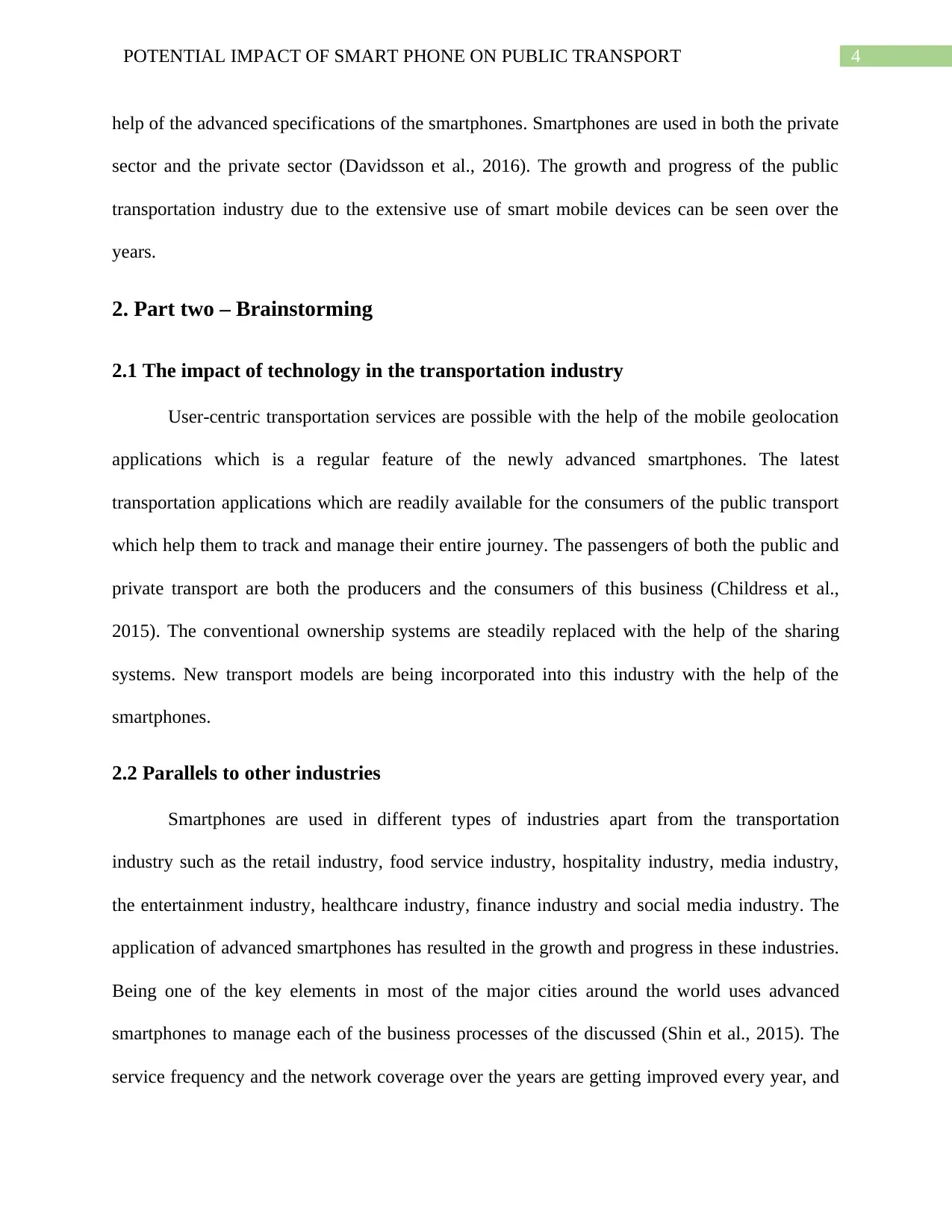
4POTENTIAL IMPACT OF SMART PHONE ON PUBLIC TRANSPORT
help of the advanced specifications of the smartphones. Smartphones are used in both the private
sector and the private sector (Davidsson et al., 2016). The growth and progress of the public
transportation industry due to the extensive use of smart mobile devices can be seen over the
years.
2. Part two – Brainstorming
2.1 The impact of technology in the transportation industry
User-centric transportation services are possible with the help of the mobile geolocation
applications which is a regular feature of the newly advanced smartphones. The latest
transportation applications which are readily available for the consumers of the public transport
which help them to track and manage their entire journey. The passengers of both the public and
private transport are both the producers and the consumers of this business (Childress et al.,
2015). The conventional ownership systems are steadily replaced with the help of the sharing
systems. New transport models are being incorporated into this industry with the help of the
smartphones.
2.2 Parallels to other industries
Smartphones are used in different types of industries apart from the transportation
industry such as the retail industry, food service industry, hospitality industry, media industry,
the entertainment industry, healthcare industry, finance industry and social media industry. The
application of advanced smartphones has resulted in the growth and progress in these industries.
Being one of the key elements in most of the major cities around the world uses advanced
smartphones to manage each of the business processes of the discussed (Shin et al., 2015). The
service frequency and the network coverage over the years are getting improved every year, and
help of the advanced specifications of the smartphones. Smartphones are used in both the private
sector and the private sector (Davidsson et al., 2016). The growth and progress of the public
transportation industry due to the extensive use of smart mobile devices can be seen over the
years.
2. Part two – Brainstorming
2.1 The impact of technology in the transportation industry
User-centric transportation services are possible with the help of the mobile geolocation
applications which is a regular feature of the newly advanced smartphones. The latest
transportation applications which are readily available for the consumers of the public transport
which help them to track and manage their entire journey. The passengers of both the public and
private transport are both the producers and the consumers of this business (Childress et al.,
2015). The conventional ownership systems are steadily replaced with the help of the sharing
systems. New transport models are being incorporated into this industry with the help of the
smartphones.
2.2 Parallels to other industries
Smartphones are used in different types of industries apart from the transportation
industry such as the retail industry, food service industry, hospitality industry, media industry,
the entertainment industry, healthcare industry, finance industry and social media industry. The
application of advanced smartphones has resulted in the growth and progress in these industries.
Being one of the key elements in most of the major cities around the world uses advanced
smartphones to manage each of the business processes of the discussed (Shin et al., 2015). The
service frequency and the network coverage over the years are getting improved every year, and
Paraphrase This Document
Need a fresh take? Get an instant paraphrase of this document with our AI Paraphraser
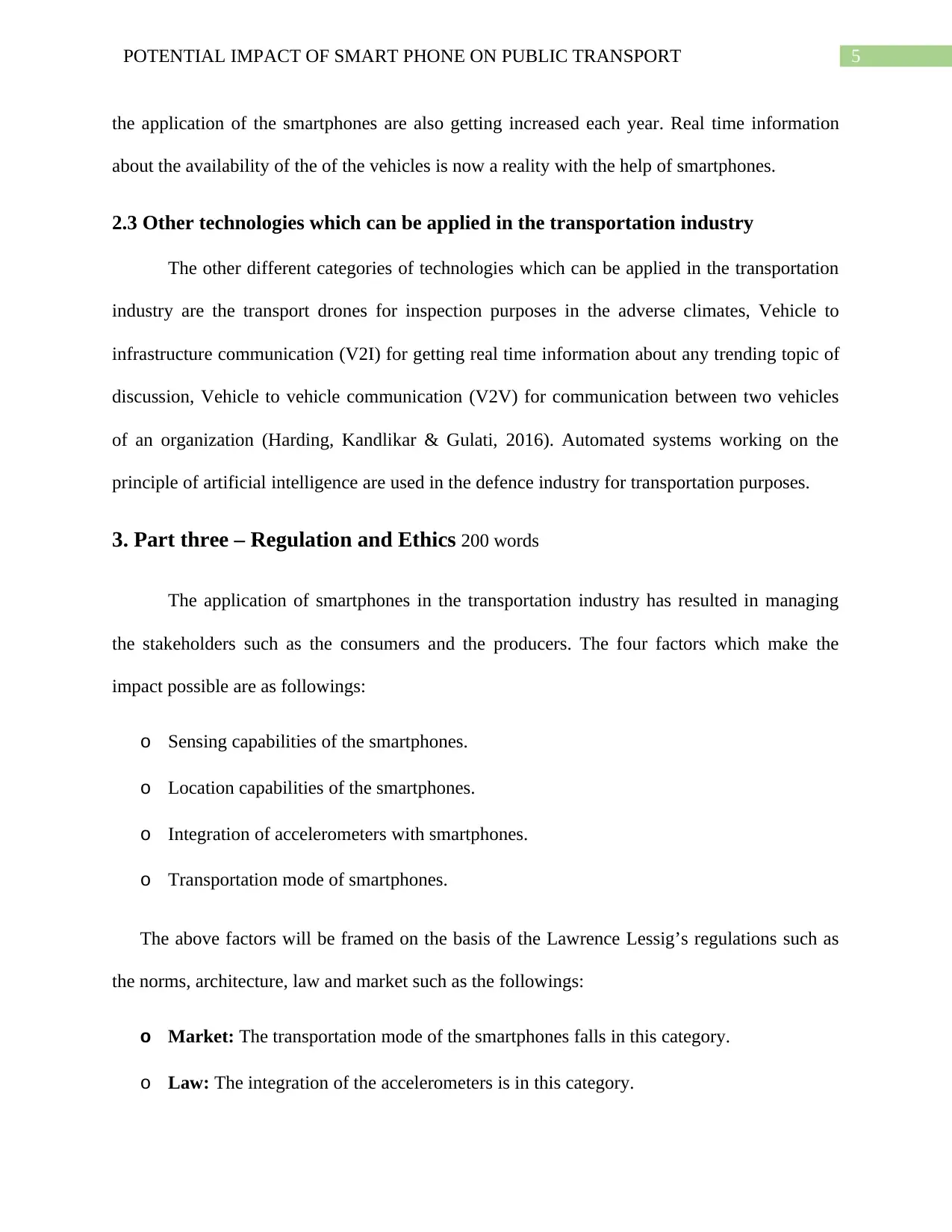
5POTENTIAL IMPACT OF SMART PHONE ON PUBLIC TRANSPORT
the application of the smartphones are also getting increased each year. Real time information
about the availability of the of the vehicles is now a reality with the help of smartphones.
2.3 Other technologies which can be applied in the transportation industry
The other different categories of technologies which can be applied in the transportation
industry are the transport drones for inspection purposes in the adverse climates, Vehicle to
infrastructure communication (V2I) for getting real time information about any trending topic of
discussion, Vehicle to vehicle communication (V2V) for communication between two vehicles
of an organization (Harding, Kandlikar & Gulati, 2016). Automated systems working on the
principle of artificial intelligence are used in the defence industry for transportation purposes.
3. Part three – Regulation and Ethics 200 words
The application of smartphones in the transportation industry has resulted in managing
the stakeholders such as the consumers and the producers. The four factors which make the
impact possible are as followings:
o Sensing capabilities of the smartphones.
o Location capabilities of the smartphones.
o Integration of accelerometers with smartphones.
o Transportation mode of smartphones.
The above factors will be framed on the basis of the Lawrence Lessig’s regulations such as
the norms, architecture, law and market such as the followings:
o Market: The transportation mode of the smartphones falls in this category.
o Law: The integration of the accelerometers is in this category.
the application of the smartphones are also getting increased each year. Real time information
about the availability of the of the vehicles is now a reality with the help of smartphones.
2.3 Other technologies which can be applied in the transportation industry
The other different categories of technologies which can be applied in the transportation
industry are the transport drones for inspection purposes in the adverse climates, Vehicle to
infrastructure communication (V2I) for getting real time information about any trending topic of
discussion, Vehicle to vehicle communication (V2V) for communication between two vehicles
of an organization (Harding, Kandlikar & Gulati, 2016). Automated systems working on the
principle of artificial intelligence are used in the defence industry for transportation purposes.
3. Part three – Regulation and Ethics 200 words
The application of smartphones in the transportation industry has resulted in managing
the stakeholders such as the consumers and the producers. The four factors which make the
impact possible are as followings:
o Sensing capabilities of the smartphones.
o Location capabilities of the smartphones.
o Integration of accelerometers with smartphones.
o Transportation mode of smartphones.
The above factors will be framed on the basis of the Lawrence Lessig’s regulations such as
the norms, architecture, law and market such as the followings:
o Market: The transportation mode of the smartphones falls in this category.
o Law: The integration of the accelerometers is in this category.
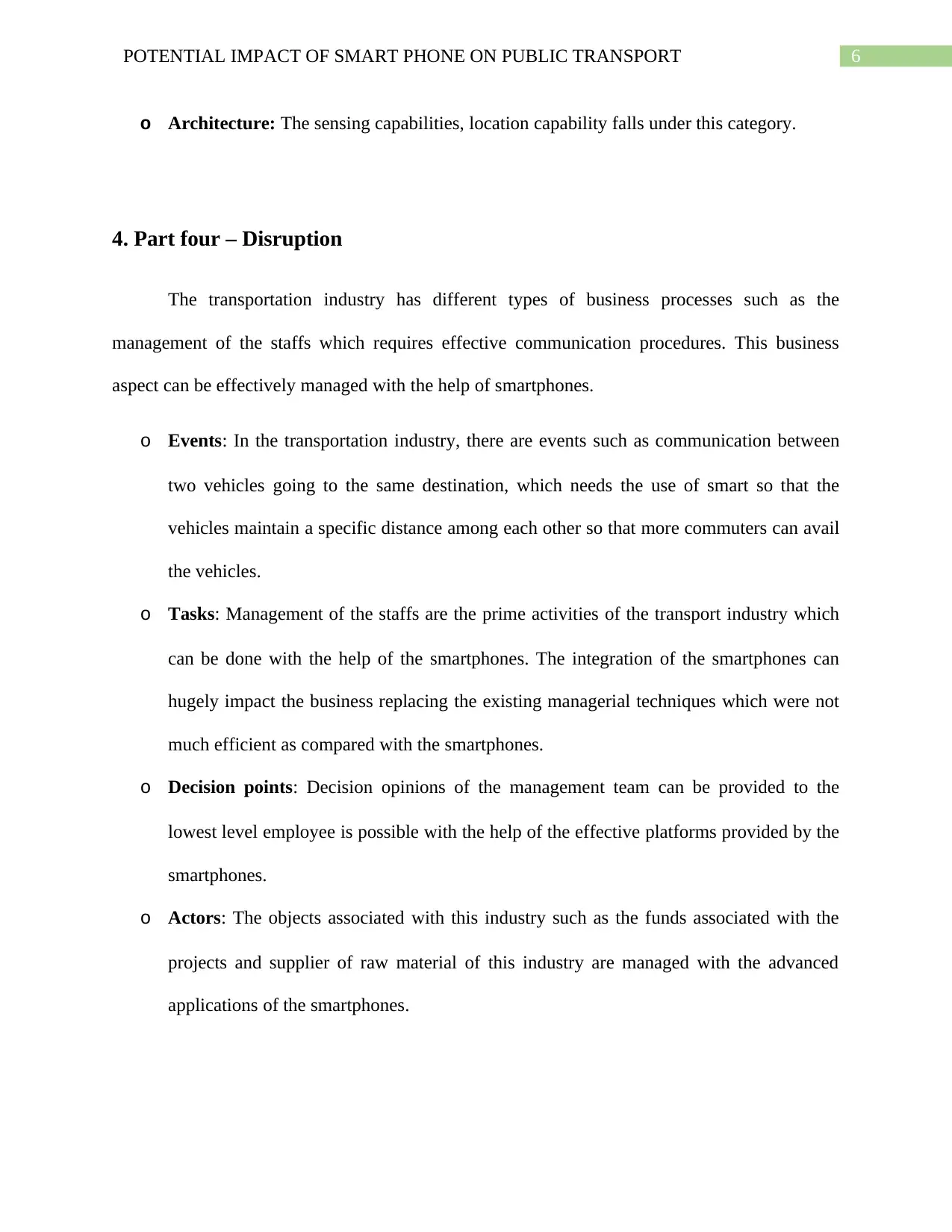
6POTENTIAL IMPACT OF SMART PHONE ON PUBLIC TRANSPORT
o Architecture: The sensing capabilities, location capability falls under this category.
4. Part four – Disruption
The transportation industry has different types of business processes such as the
management of the staffs which requires effective communication procedures. This business
aspect can be effectively managed with the help of smartphones.
o Events: In the transportation industry, there are events such as communication between
two vehicles going to the same destination, which needs the use of smart so that the
vehicles maintain a specific distance among each other so that more commuters can avail
the vehicles.
o Tasks: Management of the staffs are the prime activities of the transport industry which
can be done with the help of the smartphones. The integration of the smartphones can
hugely impact the business replacing the existing managerial techniques which were not
much efficient as compared with the smartphones.
o Decision points: Decision opinions of the management team can be provided to the
lowest level employee is possible with the help of the effective platforms provided by the
smartphones.
o Actors: The objects associated with this industry such as the funds associated with the
projects and supplier of raw material of this industry are managed with the advanced
applications of the smartphones.
o Architecture: The sensing capabilities, location capability falls under this category.
4. Part four – Disruption
The transportation industry has different types of business processes such as the
management of the staffs which requires effective communication procedures. This business
aspect can be effectively managed with the help of smartphones.
o Events: In the transportation industry, there are events such as communication between
two vehicles going to the same destination, which needs the use of smart so that the
vehicles maintain a specific distance among each other so that more commuters can avail
the vehicles.
o Tasks: Management of the staffs are the prime activities of the transport industry which
can be done with the help of the smartphones. The integration of the smartphones can
hugely impact the business replacing the existing managerial techniques which were not
much efficient as compared with the smartphones.
o Decision points: Decision opinions of the management team can be provided to the
lowest level employee is possible with the help of the effective platforms provided by the
smartphones.
o Actors: The objects associated with this industry such as the funds associated with the
projects and supplier of raw material of this industry are managed with the advanced
applications of the smartphones.
⊘ This is a preview!⊘
Do you want full access?
Subscribe today to unlock all pages.

Trusted by 1+ million students worldwide
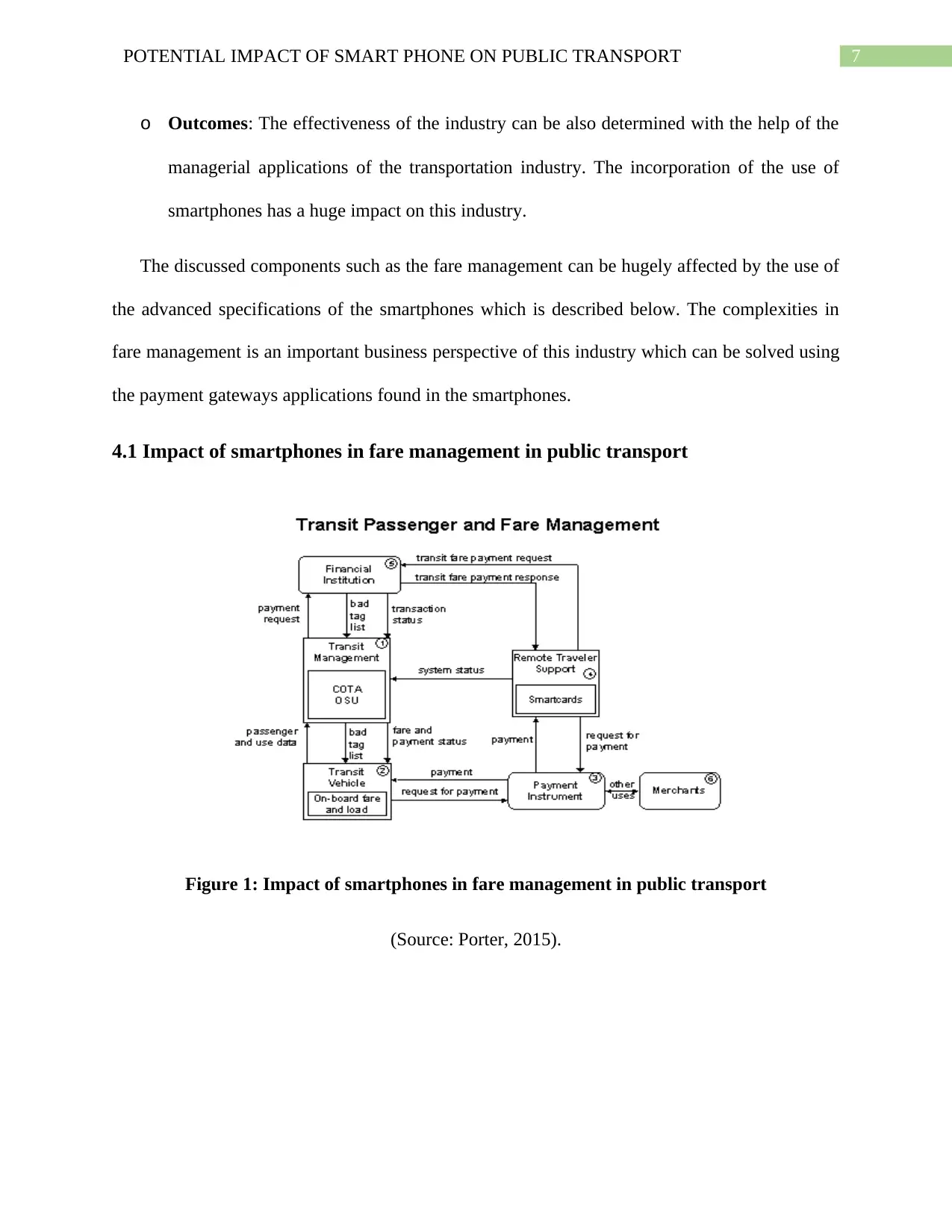
7POTENTIAL IMPACT OF SMART PHONE ON PUBLIC TRANSPORT
o Outcomes: The effectiveness of the industry can be also determined with the help of the
managerial applications of the transportation industry. The incorporation of the use of
smartphones has a huge impact on this industry.
The discussed components such as the fare management can be hugely affected by the use of
the advanced specifications of the smartphones which is described below. The complexities in
fare management is an important business perspective of this industry which can be solved using
the payment gateways applications found in the smartphones.
4.1 Impact of smartphones in fare management in public transport
Figure 1: Impact of smartphones in fare management in public transport
(Source: Porter, 2015).
o Outcomes: The effectiveness of the industry can be also determined with the help of the
managerial applications of the transportation industry. The incorporation of the use of
smartphones has a huge impact on this industry.
The discussed components such as the fare management can be hugely affected by the use of
the advanced specifications of the smartphones which is described below. The complexities in
fare management is an important business perspective of this industry which can be solved using
the payment gateways applications found in the smartphones.
4.1 Impact of smartphones in fare management in public transport
Figure 1: Impact of smartphones in fare management in public transport
(Source: Porter, 2015).
Paraphrase This Document
Need a fresh take? Get an instant paraphrase of this document with our AI Paraphraser
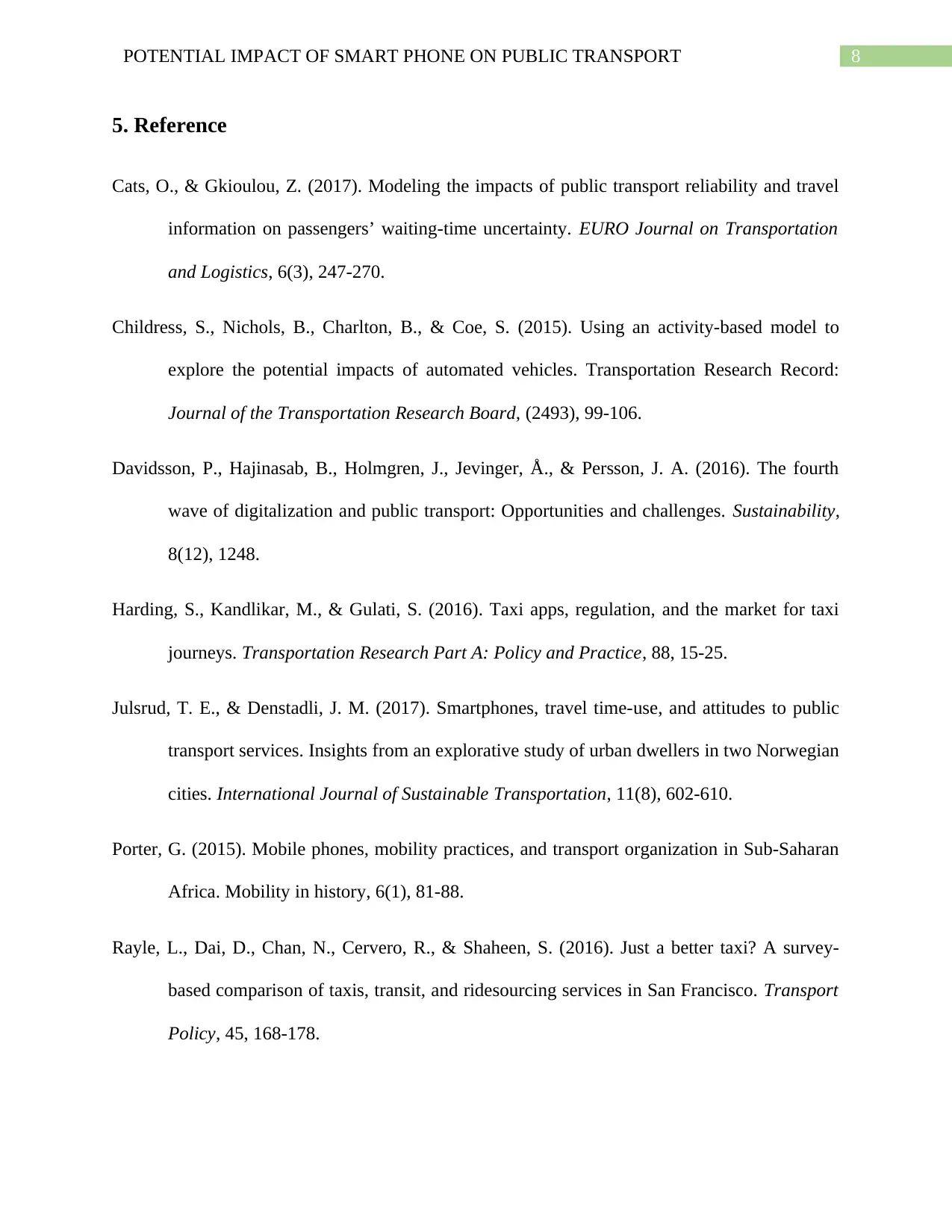
8POTENTIAL IMPACT OF SMART PHONE ON PUBLIC TRANSPORT
5. Reference
Cats, O., & Gkioulou, Z. (2017). Modeling the impacts of public transport reliability and travel
information on passengers’ waiting-time uncertainty. EURO Journal on Transportation
and Logistics, 6(3), 247-270.
Childress, S., Nichols, B., Charlton, B., & Coe, S. (2015). Using an activity-based model to
explore the potential impacts of automated vehicles. Transportation Research Record:
Journal of the Transportation Research Board, (2493), 99-106.
Davidsson, P., Hajinasab, B., Holmgren, J., Jevinger, Å., & Persson, J. A. (2016). The fourth
wave of digitalization and public transport: Opportunities and challenges. Sustainability,
8(12), 1248.
Harding, S., Kandlikar, M., & Gulati, S. (2016). Taxi apps, regulation, and the market for taxi
journeys. Transportation Research Part A: Policy and Practice, 88, 15-25.
Julsrud, T. E., & Denstadli, J. M. (2017). Smartphones, travel time-use, and attitudes to public
transport services. Insights from an explorative study of urban dwellers in two Norwegian
cities. International Journal of Sustainable Transportation, 11(8), 602-610.
Porter, G. (2015). Mobile phones, mobility practices, and transport organization in Sub-Saharan
Africa. Mobility in history, 6(1), 81-88.
Rayle, L., Dai, D., Chan, N., Cervero, R., & Shaheen, S. (2016). Just a better taxi? A survey-
based comparison of taxis, transit, and ridesourcing services in San Francisco. Transport
Policy, 45, 168-178.
5. Reference
Cats, O., & Gkioulou, Z. (2017). Modeling the impacts of public transport reliability and travel
information on passengers’ waiting-time uncertainty. EURO Journal on Transportation
and Logistics, 6(3), 247-270.
Childress, S., Nichols, B., Charlton, B., & Coe, S. (2015). Using an activity-based model to
explore the potential impacts of automated vehicles. Transportation Research Record:
Journal of the Transportation Research Board, (2493), 99-106.
Davidsson, P., Hajinasab, B., Holmgren, J., Jevinger, Å., & Persson, J. A. (2016). The fourth
wave of digitalization and public transport: Opportunities and challenges. Sustainability,
8(12), 1248.
Harding, S., Kandlikar, M., & Gulati, S. (2016). Taxi apps, regulation, and the market for taxi
journeys. Transportation Research Part A: Policy and Practice, 88, 15-25.
Julsrud, T. E., & Denstadli, J. M. (2017). Smartphones, travel time-use, and attitudes to public
transport services. Insights from an explorative study of urban dwellers in two Norwegian
cities. International Journal of Sustainable Transportation, 11(8), 602-610.
Porter, G. (2015). Mobile phones, mobility practices, and transport organization in Sub-Saharan
Africa. Mobility in history, 6(1), 81-88.
Rayle, L., Dai, D., Chan, N., Cervero, R., & Shaheen, S. (2016). Just a better taxi? A survey-
based comparison of taxis, transit, and ridesourcing services in San Francisco. Transport
Policy, 45, 168-178.
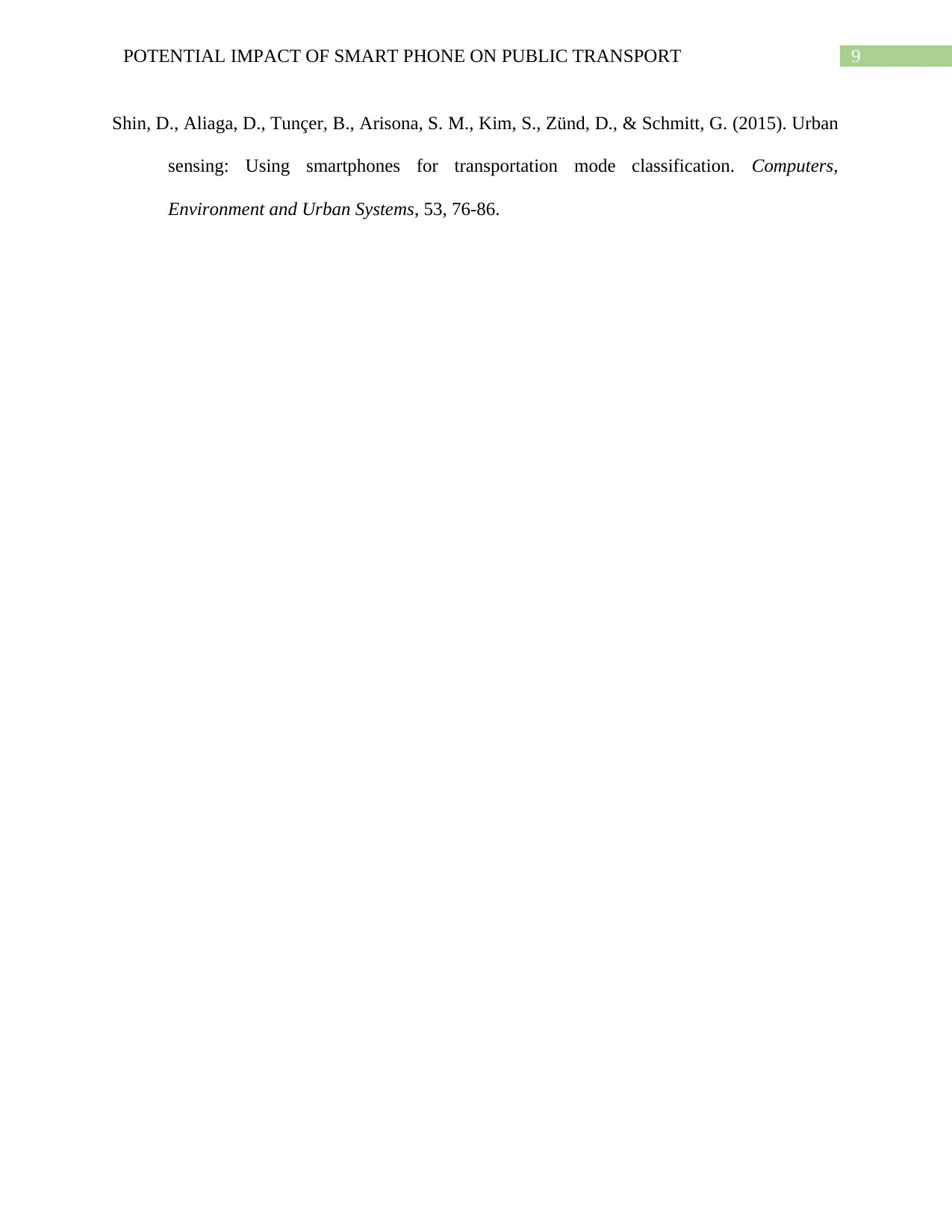
9POTENTIAL IMPACT OF SMART PHONE ON PUBLIC TRANSPORT
Shin, D., Aliaga, D., Tunçer, B., Arisona, S. M., Kim, S., Zünd, D., & Schmitt, G. (2015). Urban
sensing: Using smartphones for transportation mode classification. Computers,
Environment and Urban Systems, 53, 76-86.
Shin, D., Aliaga, D., Tunçer, B., Arisona, S. M., Kim, S., Zünd, D., & Schmitt, G. (2015). Urban
sensing: Using smartphones for transportation mode classification. Computers,
Environment and Urban Systems, 53, 76-86.
⊘ This is a preview!⊘
Do you want full access?
Subscribe today to unlock all pages.

Trusted by 1+ million students worldwide
1 out of 9
Related Documents
Your All-in-One AI-Powered Toolkit for Academic Success.
+13062052269
info@desklib.com
Available 24*7 on WhatsApp / Email
![[object Object]](/_next/static/media/star-bottom.7253800d.svg)
Unlock your academic potential
Copyright © 2020–2025 A2Z Services. All Rights Reserved. Developed and managed by ZUCOL.





